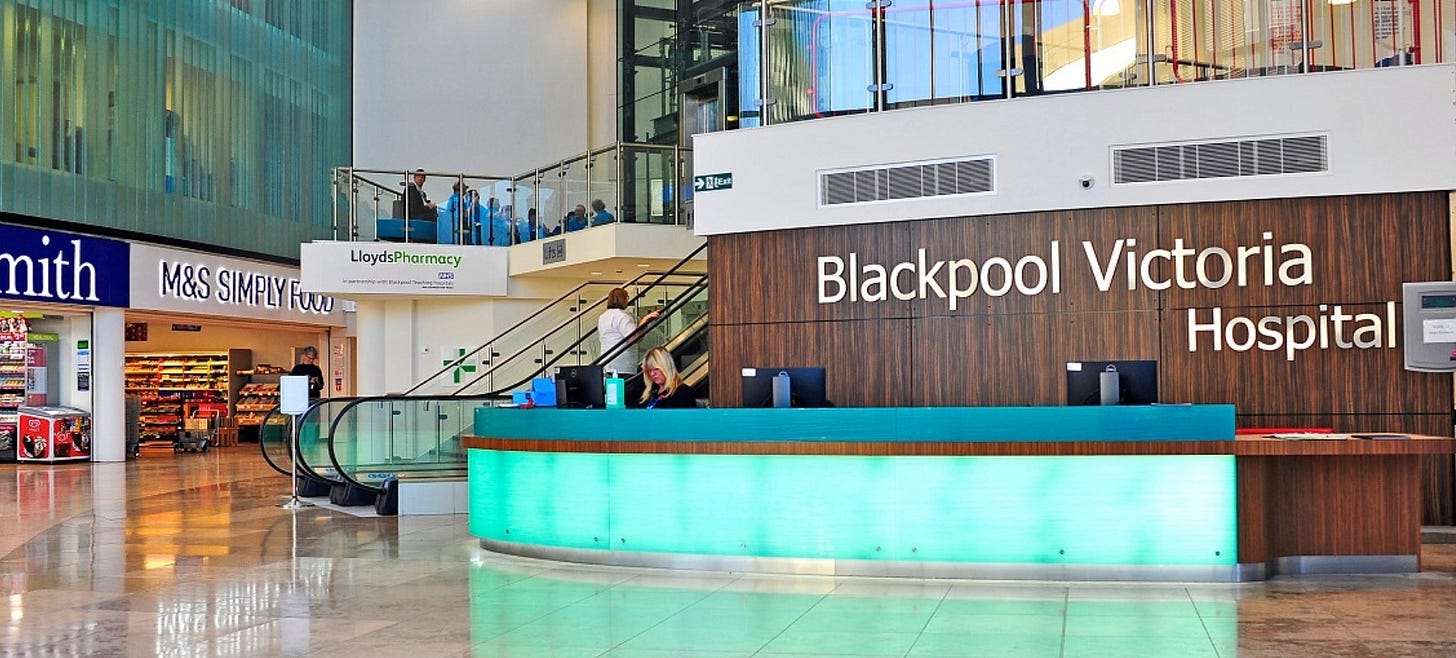Long waits at Blackpool Victoria Hospital’s A&E department lead surge in distressing sores
PLUS: What really happened with Backlot Cinema?
Hello and welcome to The Blackpool Lead.
Today we return to report on Blackpool Victoria Hospital - something we’ve continued to do since we sent our very first edition back in January 2024.
‘Sores’ doesn’t really do justice to the discomfort that can be caused by lying prone for extended periods - as all too many people are doing in A&E in 2025.
In May, which is the most recent data available, there were almost double the expected number recorded.
We also report on the story of the change of operator at Backlot Cinema - the landmark multiplex opened in 2024. It’s worth taking a read of our feature on Blackpool’s cinema history that was written at the time.
The changeover appeared to be smooth and painless on the surface - but we’ve looked more closely and found that there has been a breakdown in relationship between Blackpool Council and the operators of the cinema.
Injuries related to prolonged stays in A&E on the rise at the Vic
By Michael Holmes
Lengthy waits in Blackpool Victoria Hospital’s A&E department have triggered a surge in painful pressure sores, it can be revealed.
Chief nurse Bridget Lees said the rise in grade two ulcers - usually open wounds with swelling, discolouration and pain, caused by lying prone for extended periods - is “related to prolonged stays in accident and emergency”, with “extra training and support” being rolled out in the busy department.
Some 54 category two pressure sores were reported in May, the latest available figures show.
That is almost twice the expected number.
It comes after a 13.01% fall in such sores in 2024/25, a feat hailed by hospital bosses as a “headline achievement”.
Chief operating officer Janet Barnsley has said sorry to those affected - though the trust failed to answer The Blackpool Lead’s questions.
“We want to apologise to those patients and their families who have experienced longer wait times in our emergency department; this occurs when demands for our services are high and we understand the distress this can cause,” she said in a statement.
“Although there has been an increase in pressure sores, this is not exclusively due to long waits but a combination of different factors, which the trust is looking to reduce.
“We have thoroughly reviewed all cases and improvements have been put in place, including increased staff training and enhancing patient assessments already to increase early detection.
“Patient safety is our priority and the trust has made significant steps to improve patient flow, including our discharge processes, to ensure we reduce delays in transferring patients from the emergency department on to the wards which will support wound care planning.”
The Vic had been asked how busy A&E has been in recent years and how many people have been left waiting on trolleys or in cubicles.
It was also asked what specific changes have been made to tackle the rise of hospital-acquired pressure ulcers.
Hospital documents admit: “Pressure ulcers cause pain and distress to patients.
“They also increase (the) length of hospital stay and dependence on health care providers.
“Pressure ulcers are largely avoidable and the trust considers hospital-acquired category three and four ulcers to be internal never events (meaning they should never happen) due to their severity.
“The trust is committed to eradicating category three and four ulcers and sets challenging targets for a significant reduction of category two pressure ulcers and community-acquired pressure ulcers.”
Some 11 category three ulcers, including three in May, are being investigated for possible “lapses in care”, The Blackpool Lead has also learned.
Category three ulcers is classed as a sore involving full-thickness skin loss, with damage or the death of tissue.
Fat could be visible beneath the skin but bones, muscle, tendons and ligaments or cartilage is not exposed - that would see the injury classed as a category four sore.
A new national wound care strategy has been brought in at the Vic, in Whinney Heys Road, with previously uncategorised skin damage now being reported as category three ulcers, hospital documents say.
“Therefore, the total number of categories three will and has increased,” the papers show.
“However, this is not additional damage but a recategorisation.”
The Vic did not say, when asked by The Blackpool Lead, how specifically the new national wound care strategy affected category three sore rates.
There have been no category four sores reported.
Behind-the-scenes breakdown in relationship behind change of operator at Backlot Cinema
By Jamie Lopez & Luke Beardsworth
A seemingly smooth transition at Backlot cinema has hidden a breakdown in relationship between the outgoing operator and Blackpool Council, The Blackpool Lead can reveal.
Keep reading with a 7-day free trial
Subscribe to The Blackpool Lead to keep reading this post and get 7 days of free access to the full post archives.







